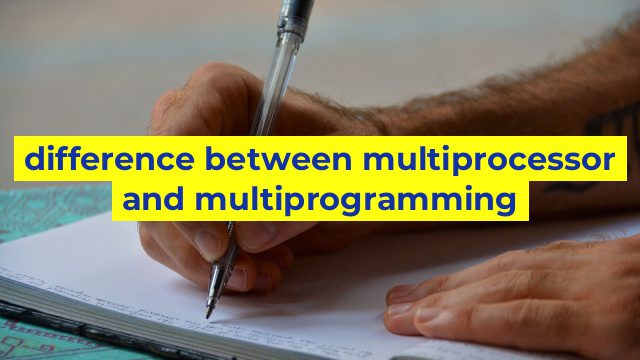Understanding the Difference Between Multiprocessing and Multiprogramming
When it comes to computer programming, there are two terms that people often come across – multiprocessing and multiprogramming. While both concepts are used to improve computer performance, they are not interchangeable. In this article, we will explore the difference between multiprocessing and multiprogramming.
Multiprocessing Explained
Multiprocessing refers to a system that has more than one processor, each working concurrently to execute multiple tasks. Each processor can handle different tasks simultaneously, providing a significant boost in overall system performance.
Multiprocessing is common in high-end servers and some desktop computers. The system assigns the tasks to different processors, and each processor completes its allocated task independently without interruption. This allows multiple programs to run simultaneously without slowing down the system.
The advantage of multiprocessing is that it enhances the processing speed of the system, enabling more intensive and compute-intensive workloads to be executed simultaneously.
Multiprogramming Explained
Multiprogramming relates to running multiple programs on a single processor characterized by sharing the processor’s resources among several programs. The processor can switch between each program, executing a part of each program in a round-robin fashion.
For instance, imagine a computer that runs a word processor, calculator, and web browser simultaneously. The processor will cycle through each program in a loop, giving each application a share of the processor’s time. Although the applications can’t run at the same time, they can appear to run in parallel since the processor rapidly switches between each application.
Multiprogramming improves system efficiency by maximizing the use of the processor, ensuring that the processor doesn’t sit idle, waiting for a single application to finish executing. Consequently, the system can complete multiple tasks in a short amount of time.
The Primary Differences Between Multiprocessing and Multiprogramming
The main difference between multiprocessing and multiprogramming is that multiprocessing focuses on hardware while multiprogramming is software-based. While both concepts are used to improve computer performance, multiprocessing aims to increase system performance by adding more CPUs to the system, while multiprogramming intends to increase system performance by allowing multiple programs to run on a single CPU.
Another primary difference is that multiprocessing allows several programs to execute simultaneously, while multiprogramming only allows a single program to execute at any given time.
Conclusion
In conclusion, multiprocessing and multiprogramming are two different concepts in computer programming. Multiprocessing focuses on hardware and allows for the execution of multiple tasks simultaneously by adding more CPUs to the system, while multiprogramming focuses on software and allows multiple programs to run on a single CPU by sharing the processor’s time. Understanding the differences between the two concepts helps app developers select the appropriate technology to create an efficient computing system.
Table difference between multiprocessor and multiprogramming
| Feature | Multiprocessing | Multiprogramming |
|---|---|---|
| Definition | A computer system with multiple CPUs that work in parallel to execute multiple tasks at once | A computer system that runs multiple programs simultaneously to maximize CPU utilization |
| Resource sharing | Each processor has its own memory and I/O channels but can communicate with other processors through interconnection networks | Single processor is shared among multiple processes and must allocate resources efficiently to prevent contention |
| Performance | Higher performance due to parallel processing of multiple tasks | Lower performance compared to multiprocessing as only one process can run at a time on each CPU |
| Fault tolerance | Fault-tolerant as tasks can be redistributed to other processors in case of one processor failure | Less fault-tolerant as a failure in one process can affect other processes sharing the same resources |
| Cost | Higher cost due to the need for multiple CPUs and associated hardware and software | Lower cost as the system requires only a single CPU and software for efficient resource allocation |

